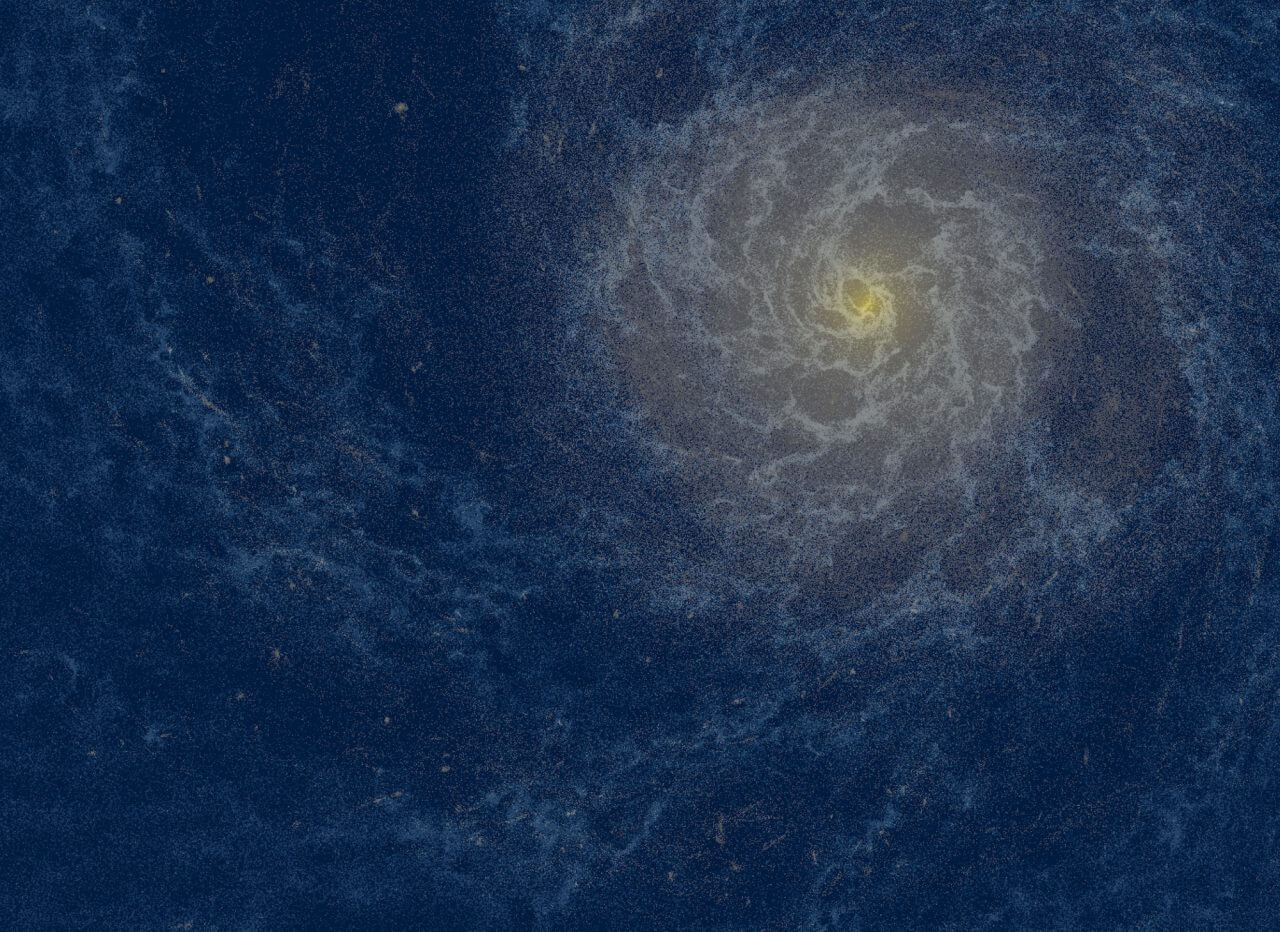[▲ توزيع النجوم (الأصفر) والغاز (الأزرق) في محاكاة تكوين مجرة درب التبانة (مصدر الصورة: Yutaka Hirai)]
A research team headed by Yu Hirai, a researcher at Tohoku University Graduate School of Science, has discovered that many stars rich in precious metals (elements heavier than iron, such as gold and platinum) found in the Milky Way will form later. Milky Way Galaxy: Research results announced that it was born more than 10 billion years ago in a young galaxy.
In the early universe, only hydrogen, helium, and a small amount of lithium existed. Heavier elements, even iron, were generated by nuclear fusion reactions inside stars. Heavier elements were generated and released by violent phenomena such as supernova explosions. It is believed to have increased gradually with the progression of successive generations of stars.
Many of the stars in the Milky Way have a ratio of precious metals to iron more than five times that of the Sun. To understand when and how these precious metal-rich stars formed, the research team used the National Astronomical Observatory’s Japanese astronomical computer Atirui-2 to simulate the formation of the Milky Way over 13.8 billion years. As a result, more than 90% of the stars rich in precious metals are said to have formed in small galaxies in the process of formation within 4 billion years after the birth of the universe (more than 9.8 billion years ago).
[فيديو لمحاكاة الاختبار في هذا البحث (محسوب بدقة 1/100 من الاختبار الفعلي)]
The yellow glow represents stars, and the faint cloud-like objects represent gas.
(Credit: Takayuki Saito/Takaki Takeda)
This simulation takes into account a nucleosynthetic process called the “r-process,” in which precious metals are produced in conjunction with the “kilonova” explosion phenomenon that occurs when neutron stars merge. In small galaxies, the amount of hydrogen gas, which is the raw material for stars, is small, and even with a small number of neutron star mergers, the percentage of precious metals in the entire galaxy is high.
In addition, when comparing the amount of europium (Eu), a precious metal, both simulation and actual observation data showed a similar distribution. From this, the research team indicates that many of the stars rich in precious metals found in the Milky Way were formed more than 10 billion years ago, and that they are stars that tell the history of the formation of the Milky Way in the early universe. a plus.
![[▲ مقارنة توزيع أيام اليوروبيوم (Eu) والحديد (Fe) بين محاكاة تكوين مجرة درب التبانة (باللون الأزرق) والملاحظة الفعلية (باللون البرتقالي) (Credit: Yutaka Hirai et al.)]](https://technewsinsight.com/wp-content/uploads/2022/12/1669915836_996_Stars-rich-in-precious-metals-were-born-more-than-10.jpg)
[▲ مقارنة توزيع أيام اليوروبيوم (Eu) والحديد (Fe) بين محاكاة تكوين مجرة درب التبانة (باللون الأزرق) والملاحظة الفعلية (باللون البرتقالي) (Credit: Yutaka Hirai et al.)]
The research team will use the RIKEN “Fugaku” supercomputer to perform simulations and observations from Japan’s Subaru Telescope, the National Astronomical Observatory of Japan’s Hawaiian Observatory. It is said that we will challenge clarify
source
- Tohoku University – Stars rich in precious metals are 10 billion years old. Successful simulation of the Milky Way, the highest resolution in the world
- National Astronomical Observatory of Japan – Stars rich in precious metals are 10 billion years old – Successful simulation of the Milky Way with the highest resolution in the world –
- Yutaka Hirai and others. – Dramatically improved star origin in a cosmic approximation to simulate a Milky Way-like galaxy
Text / Takehiro Matsumura

“Travel maven. Beer expert. Subtly charming alcohol fan. Internet junkie. Avid bacon scholar.”







More Stories
Global Gear launches new casual game “Psycho Boy 2”…the latest in the popular loose escape game series with a total of 120 million views on TikTok |
Voyager action in the 'Planetary' pavilion to celebrate 47 years of spacecraft's achievements World Premiere at Sumida in Tanabata: Tokyo Shimbun Tokyo Web
Rocks taken out from NASA's experiment to change the orbit of an asteroid may collide with Mars in the future. Space Portal website |